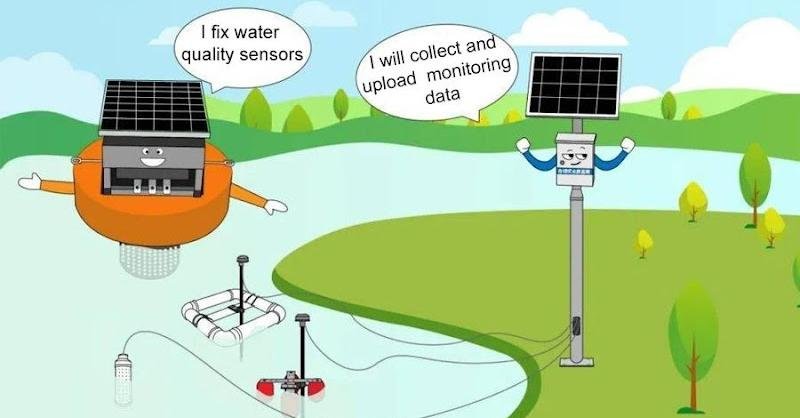Dissolved oxygen definition
Dissolved oxygen refers to oxygen dissolved in water (i.e. O2 in water), expressed as DO. Dissolved oxygen provides oxygen for the growth and development of aquatic organisms. Oxygen from the atmosphere is a potential source with untapped, once dissolved oxygen levels deplete below saturation in water. An important source is the oxygen which is discharged by aquatic plants during photosynthesis. The concentration of dissolved oxygen varies with temperature, air pressure and salinity. This warming process also means more and more salt can be carried, which in turn will allow lower dissolved oxygen values. The greater the air pressure, the more oxygen will be dissolved in water.
The amount of dissolved oxygen has a close relationship with the partial pressure of air and atmospheric pressure, water temperature and degree of water pollution等! The concentration of oxygen at 20ºC and a partial pressure of about 100kPa in pure water is approximatately9mg/L. Aerobic bacteria degrade certain types of organic compounds, using up larger amounts of dissolved oxygen in the water. C + O2 = CO232 g of oxygen is consumed for every 12g of carbon. If the value drops to 5mg/L, this is when some fish start struggling with breathing.
As well as being taken into reducing substances such at sulfide, nitrite and ferrous ions in the water dissolved oxygen is also used by micro- biological respiration both within trophic levels of organisms (bacteria and protozoa) and introduced residues from aerobic foods. Consequently, the dissolved oxygen level may be indicative of a bodies ability to self-purify water.
The clean level of drinking water is characterized by academic examination index Dissolved oxygen value. When the dissolved oxygen in water is consumed and it can return to a state of equilibrium within a short time, this suggests that the self-purification capacity of a body of water itself is strong or occurs little pollution. If not, this is a severe pollution event indicating water quality that can no longer self-cleanse or Outfall.
Why do we need to measure dissolved oxygen?
About (9ppm)],[near saturation value of dissolved oxygen in water in nature Dissolved Oxygen falls as algae growth is so powerful that they reproduce in enough numbers. Dissolved oxygen is reduced by water pollution of organic mater and reducing substances. In addition to aquaculture, the dissolved oxygen in the breeding environment of fish and shrimp directly affect their metabolic intensity affecting growth. Mechanical air aeration is however not as easy to maintain the DO content in water body at 5 mg/L Hundreds of farmers often face several issues while breeding, most commonly the demand vs supply failures in dissolved oxygen.
There can still be no less than 6 mg / L of dissolved oxygen in healthy drinking water for humans and when the rate of the consumption amount is higher then that one oxygen dissolves into water, content approaching zero percent. Anaerobic bacteria can reproduce and generate of sewage, so the DO reflect water pollution degree said in some articles about our environment audio. Dissolved oxygen is an important index to detect the degree of water pollution and a comprehensive standard for measuring water quality. So the DO monitoringof aquaculture farms is beneficial for protecting environment and promoting aquacultural development.
How to measure dissolved oxygen?
-
Iodometric method
It employs manganese sulfate and alkaline potassium iodide reagents to measure the dissolved oxygen content because this reaction oxidizes dissolved oxygen into manganate. More specifically, the steps are as follows: adding manganese sulfate solution and alkaline potassium iodide reagent to a sample of dissolved oxygen; subsequently titrating manganate ions in situ with trivalent iron(Fe) solution acidified by sulfuric acid. The dissolved oxygen concentration can be determined by the consumption of trivalent iron solution.
-
Dissolved oxygen sensor
Membrane electrode method
The dissolved oxygen meter consists of two parts and the display instrument The dissolved oxygen sensor part is made up of a gold electrode (cathode), silver electrode (negative pole) and electrolyte with potassium chloride or potassium hydroxide. The oxygen that diffuses through the membrane into the electrolyte is measured by oxidation at a gold and silver electrode.
Fluorescence method
However, to be able to measure dissolved oxygen in liquid with fluorescence, the contact of fluorescent substance and action on relase by oxy gen must fullfiled. Oxygen flows to an optical dissolved oxygen sensor can enter, diffuse into regions including where the fluorescent molecules are. Fluorescence (most of the absorbed energy is released) when there is no oxygen. However this time with the presence of oxygen, because intact they reabsorb any energy strike present and thus do not luminesce.
It is with the principle of quenching active fluorescence by specific substances in physics,developed a series patented products such as dissolved oxygen sensor and other online monitoring devices…[more] The blue light emitted by the LED shines on some fluorescent substance deposited on that surface, and as a result excites some or all of the active molecules present in this electrode film to order-increasing state. The high-energy fluorescent molecules become excited and will fluoresce upon releasing energy in an environment without oxygen. Oops, that should be “in the presence of oxygen”:High-energy states in fluorescent molecules can also transfer their energy to molecular oxygen (O2), resulting in its transformation into a singletstate. In contrast with typical fluorescence degradation, this reaction entails competition between loss processes other than photon emission oremission yields less energy per event but happens much faster. This measures the light emitted as a result of excitation and release process of energy from the fluorescent molecule [oxygen] which, in turn, is again different depending upon oxygen partial pressure.










